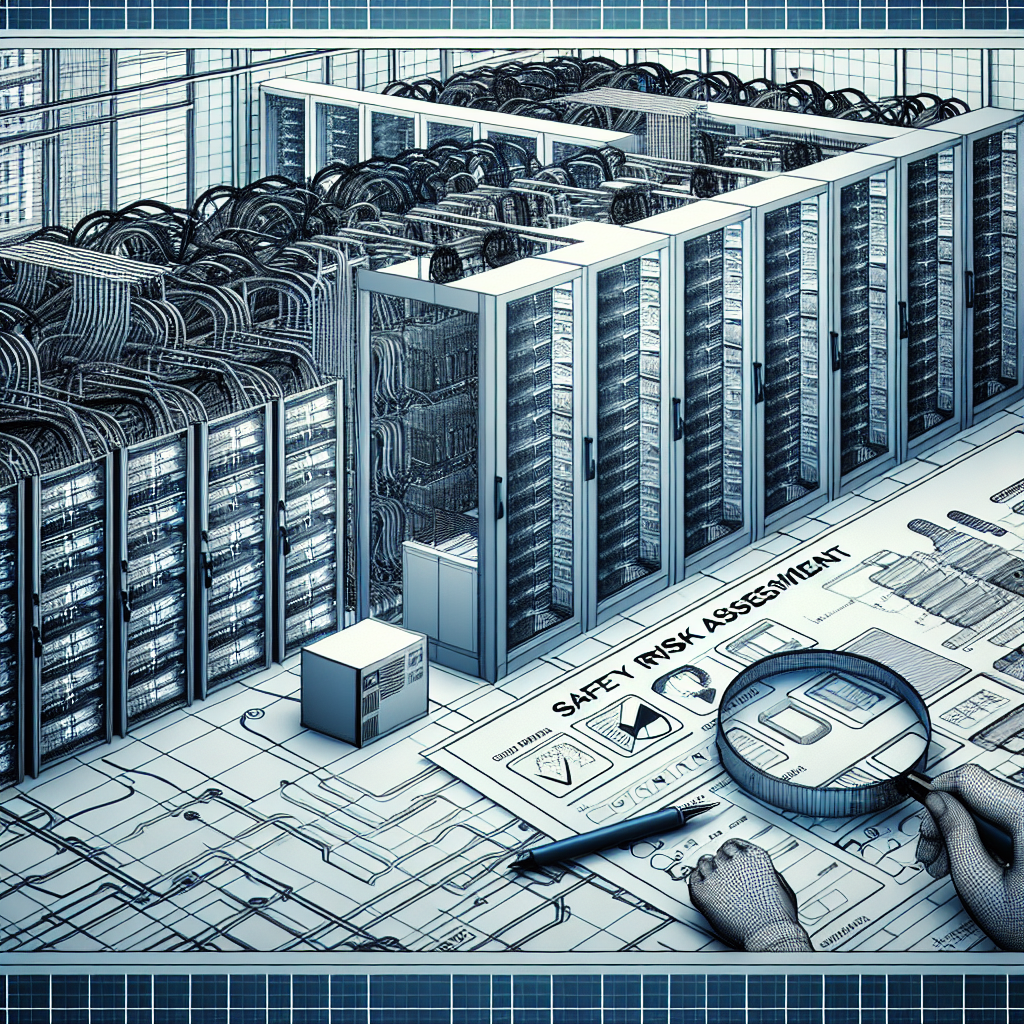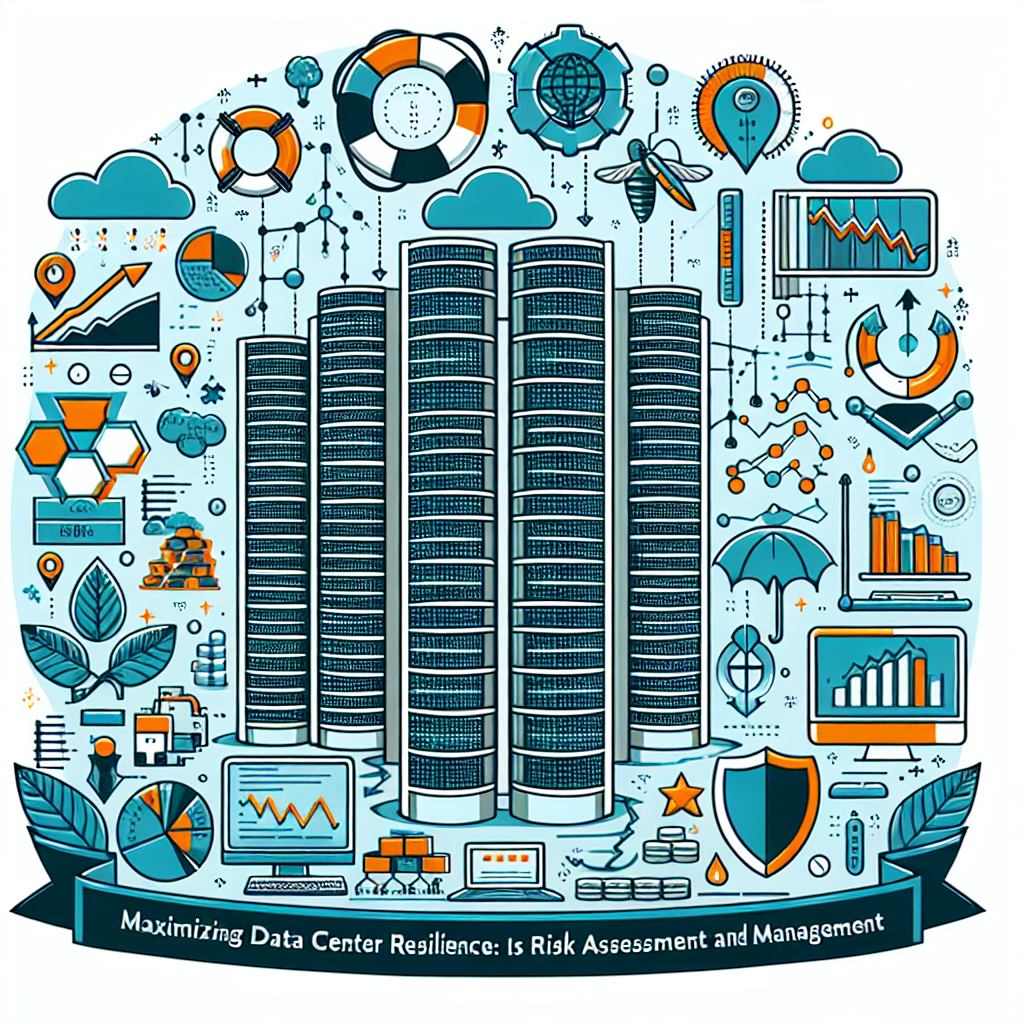Your cart is currently empty!
Tag: Data Center Risk Assessment

Mitigating Data Center Risks: The Role of Risk Assessment
Data centers are the backbone of modern businesses, housing essential IT infrastructure and storing crucial data. With the increasing reliance on technology, the importance of data centers cannot be overstated. However, with this importance comes a great deal of risk. From natural disasters to cyberattacks, data centers are vulnerable to a range of threats that can have serious consequences for businesses.To effectively manage these risks, data center operators must conduct regular risk assessments. A risk assessment is a systematic process that identifies potential hazards and evaluates the likelihood and impact of those hazards on the data center. By conducting a risk assessment, data center operators can proactively identify vulnerabilities and develop strategies to mitigate them.
One of the key benefits of conducting a risk assessment is that it allows data center operators to prioritize risks based on their potential impact. Not all risks are created equal, and some may have a more significant impact on the data center than others. By identifying and prioritizing these risks, data center operators can allocate resources more effectively to address the most critical vulnerabilities.
Another benefit of conducting a risk assessment is that it helps data center operators develop a comprehensive risk management plan. This plan outlines the strategies and measures that will be implemented to mitigate the identified risks. This may include implementing physical security measures, such as access control systems and surveillance cameras, to prevent unauthorized access to the data center. It may also involve implementing cybersecurity measures, such as firewalls and intrusion detection systems, to protect against cyberattacks.
In addition to identifying and prioritizing risks, a risk assessment also helps data center operators comply with regulatory requirements. Many industries have strict regulations governing the security and privacy of data, and failure to comply with these regulations can result in severe penalties. By conducting a risk assessment, data center operators can ensure that they are in compliance with these regulations and avoid costly fines.
Overall, conducting a risk assessment is essential for mitigating data center risks and ensuring the continued operation of the data center. By identifying vulnerabilities, prioritizing risks, and developing a comprehensive risk management plan, data center operators can protect their critical IT infrastructure and data from a range of threats. In today’s digital age, where data is king, it is crucial for businesses to take proactive steps to safeguard their data centers and mitigate potential risks.

Key Steps for Conducting a Successful Data Center Risk Assessment
Data centers play a crucial role in the operation of businesses and organizations, as they house and manage critical data and IT infrastructure. With the growing complexity and importance of data centers, it is essential for companies to conduct regular risk assessments to identify and mitigate potential threats to their data center operations. By conducting a thorough risk assessment, organizations can ensure the security, availability, and reliability of their data center environment. In this article, we will discuss the key steps for conducting a successful data center risk assessment.1. Identify Assets and Data Flows: The first step in conducting a data center risk assessment is to identify all assets and data flows within the data center environment. This includes servers, storage devices, networking equipment, applications, and data stored within the data center. Understanding the flow of data and how it is processed within the data center is essential for identifying potential vulnerabilities and risks.
2. Assess Vulnerabilities: Once assets and data flows have been identified, the next step is to assess vulnerabilities within the data center environment. This involves identifying potential weaknesses in hardware, software, and processes that could be exploited by malicious actors. Vulnerability scans and penetration testing can help identify potential security gaps that need to be addressed.
3. Evaluate Threats: In addition to assessing vulnerabilities, it is important to evaluate potential threats to the data center environment. This includes external threats such as cyberattacks, natural disasters, and physical security breaches, as well as internal threats such as human error and unauthorized access. Understanding the potential threats to the data center environment is crucial for developing effective risk mitigation strategies.
4. Determine Impact: Once vulnerabilities and threats have been identified, the next step is to determine the potential impact of these risks on the data center environment. This involves assessing the potential consequences of a security breach or system failure, including data loss, downtime, financial loss, and damage to reputation. Understanding the potential impact of risks can help prioritize mitigation efforts and allocate resources effectively.
5. Develop Risk Mitigation Strategies: Based on the findings of the risk assessment, organizations should develop risk mitigation strategies to address identified vulnerabilities and threats. This may include implementing security controls, updating software and hardware, enhancing physical security measures, and developing incident response plans. Risk mitigation strategies should be tailored to the specific risks identified in the data center environment.
6. Monitor and Review: Conducting a data center risk assessment is not a one-time activity, but an ongoing process. Organizations should regularly monitor the data center environment for new vulnerabilities and threats, and review and update risk mitigation strategies as needed. Regularly reviewing and updating risk assessments ensures that organizations stay ahead of evolving threats and maintain the security and resilience of their data center operations.
In conclusion, conducting a successful data center risk assessment is essential for ensuring the security, availability, and reliability of data center operations. By following the key steps outlined in this article, organizations can identify and mitigate potential risks to their data center environment, and enhance the overall security posture of their IT infrastructure. Investing time and resources in conducting a thorough risk assessment can help organizations proactively manage risks and protect their critical data and IT assets.

Data Center Risk Assessment: A Critical Step in Ensuring Business Continuity
In today’s digital age, data centers play a crucial role in the operations of businesses of all sizes. These facilities house and manage vast amounts of data, applications, and systems that are essential for the day-to-day functioning of organizations. However, with the increasing reliance on technology and the ever-evolving threat landscape, data centers are also at risk of experiencing various disruptions that could potentially threaten the continuity of business operations.To mitigate these risks, data center risk assessment is a critical step that organizations must undertake to ensure the resilience and continuity of their business. By conducting a thorough evaluation of potential risks and vulnerabilities, businesses can identify and prioritize areas of improvement to enhance the overall security and reliability of their data centers.
One of the key components of data center risk assessment is identifying potential threats that could impact the facility. This includes natural disasters such as earthquakes, floods, or hurricanes, as well as man-made threats like cyber-attacks, power outages, or equipment failures. By understanding the likelihood and potential impact of these threats, organizations can develop proactive strategies to mitigate risks and minimize the potential damage to their data centers.
In addition to identifying threats, data center risk assessment also involves evaluating the effectiveness of existing security measures and controls. This includes assessing the physical security of the facility, such as access controls, surveillance systems, and perimeter defenses, as well as the cybersecurity measures in place to protect against cyber threats. By conducting regular security audits and assessments, organizations can identify gaps in their security posture and implement necessary improvements to enhance the overall resilience of their data centers.
Furthermore, data center risk assessment also involves evaluating the impact of potential disruptions on business operations. This includes assessing the criticality of data and systems housed in the data center, as well as the dependencies of other business functions on these resources. By understanding the potential impact of a data center outage on the business, organizations can develop robust continuity plans and disaster recovery strategies to minimize downtime and ensure the continuity of operations.
Overall, data center risk assessment is a critical step in ensuring the resilience and continuity of business operations in today’s digital age. By identifying and prioritizing potential risks, evaluating the effectiveness of existing security measures, and assessing the impact of potential disruptions, organizations can develop proactive strategies to mitigate risks and enhance the overall security and reliability of their data centers. Ultimately, investing in data center risk assessment is a crucial step towards safeguarding the continuity of business operations and protecting the valuable data and resources housed in these facilities.

How to Prioritize Risks Identified in a Data Center Assessment
A data center assessment is crucial for identifying potential risks that could compromise the security and efficiency of the facility. Once these risks have been identified, it is important to prioritize them in order to address the most critical issues first. Prioritizing risks allows data center managers to allocate resources effectively and mitigate the most significant threats to the organization’s data and infrastructure.Here are some steps to help prioritize risks identified in a data center assessment:
1. Assess the Impact: The first step in prioritizing risks is to assess the potential impact they could have on the data center and the organization as a whole. Consider the potential consequences of each risk, such as data loss, system downtime, or financial loss. Risks that have the potential to cause the most damage should be prioritized higher.
2. Evaluate the Likelihood: Next, consider the likelihood of each risk occurring. Some risks may be more probable than others, based on factors such as the current state of the data center infrastructure, the effectiveness of security measures, and the level of internal and external threats. Risks that are more likely to occur should be given higher priority.
3. Consider Regulatory Compliance: Data centers are subject to various regulatory requirements, such as GDPR, HIPAA, and PCI DSS. Risks that could result in non-compliance with these regulations should be prioritized, as they could lead to legal consequences and financial penalties.
4. Evaluate Security Controls: Assess the effectiveness of existing security controls in mitigating the identified risks. Risks that are not adequately addressed by current security measures should be given higher priority, as they pose a greater threat to the data center’s security.
5. Consider Business Impact: Finally, consider the potential impact of each risk on the organization’s business operations. Risks that could disrupt critical business processes or affect the availability of key services should be prioritized, as they could have a significant impact on the organization’s reputation and financial stability.
Once risks have been prioritized, data center managers can develop a risk mitigation plan that focuses on addressing the most critical issues first. This plan should include specific actions to reduce or eliminate the identified risks, such as implementing additional security measures, updating policies and procedures, and training staff on best practices for data center security.
By prioritizing risks identified in a data center assessment, organizations can take a proactive approach to managing security threats and protecting their valuable data and infrastructure. Prioritizing risks ensures that resources are allocated effectively and that the most critical issues are addressed in a timely manner, reducing the likelihood of data breaches and other security incidents.

Data Center Security: Assessing Risks and Implementing Solutions
Data centers are crucial components of modern businesses, serving as the backbone of their IT infrastructure. With the increasing reliance on digital data and cloud services, data center security has become a top priority for organizations to protect their sensitive information and ensure business continuity. As cyber threats continue to evolve, it is essential for companies to assess the risks and implement robust security solutions to safeguard their data centers.Assessing Risks
Before implementing security measures, it is crucial for organizations to conduct a comprehensive risk assessment to identify potential vulnerabilities and threats to their data centers. This involves evaluating the physical security of the facility, as well as assessing the network infrastructure, systems, and applications for potential weaknesses. Some common risks that organizations may face include:
1. Unauthorized access: Physical security breaches, such as unauthorized access to the data center, can lead to theft or tampering of sensitive data.
2. Malware and cyber threats: Malicious software and cyber attacks can compromise the integrity and confidentiality of data stored in the data center.
3. Insider threats: Employees or contractors with access to the data center may pose a security risk through intentional or unintentional actions.
4. Data breaches: Data breaches can occur due to inadequate security measures, leading to the exposure of sensitive information to unauthorized parties.
Implementing Solutions
Once the risks have been identified, organizations can implement a range of security solutions to mitigate potential threats and protect their data centers. Some key strategies include:
1. Access control: Implementing strict access control measures, such as biometric authentication and access badges, can help prevent unauthorized individuals from entering the data center.
2. Encryption: Encrypting data at rest and in transit can help protect sensitive information from unauthorized access or theft.
3. Network security: Deploying firewalls, intrusion detection systems, and regular security audits can help defend against cyber threats and malware attacks.
4. Security monitoring: Implementing 24/7 security monitoring and incident response procedures can help detect and respond to security incidents in a timely manner.
5. Physical security: Enhancing physical security measures, such as surveillance cameras, alarms, and security guards, can help deter unauthorized access to the data center.
In addition to these measures, organizations should also regularly update their security policies and procedures, conduct security training for employees, and perform regular security audits to ensure the effectiveness of their security controls.
In conclusion, data center security is a critical aspect of safeguarding sensitive information and ensuring the continuity of business operations. By assessing the risks and implementing robust security solutions, organizations can protect their data centers from potential threats and mitigate the impact of security incidents. As cyber threats continue to evolve, it is essential for organizations to stay vigilant and proactive in implementing security measures to protect their data centers and maintain the trust of their customers.

The Importance of Conducting a Thorough Data Center Risk Assessment
In today’s digital age, data centers play a crucial role in storing and processing vast amounts of information for businesses of all sizes. With the increasing reliance on technology and the ever-growing threat of cyber attacks, it is more important than ever for companies to conduct a thorough risk assessment of their data centers.A data center risk assessment is a comprehensive evaluation of the potential threats and vulnerabilities that could impact the security and functionality of a data center. This includes assessing physical security measures, such as access controls and surveillance systems, as well as evaluating the effectiveness of cybersecurity protocols and procedures.
One of the key reasons why conducting a thorough data center risk assessment is important is to identify potential weaknesses in the system that could be exploited by malicious actors. By proactively identifying and addressing these vulnerabilities, companies can significantly reduce the risk of a data breach or cyber attack.
Furthermore, a data center risk assessment can help companies comply with industry regulations and standards, such as the General Data Protection Regulation (GDPR) or the Health Insurance Portability and Accountability Act (HIPAA). By ensuring that data centers meet the necessary security requirements, companies can avoid costly fines and penalties for non-compliance.
Additionally, a data center risk assessment can help companies prioritize their security investments and allocate resources more effectively. By understanding the most significant threats and vulnerabilities facing their data centers, companies can focus on implementing security measures that provide the greatest impact and protection.
Overall, conducting a thorough data center risk assessment is essential for ensuring the security and integrity of a company’s data. By identifying potential risks and vulnerabilities, companies can take proactive steps to mitigate these threats and protect their valuable information. In today’s digital landscape, where cyber attacks are becoming increasingly sophisticated, it is more important than ever for companies to prioritize data center security and conduct regular risk assessments.

Maximizing Data Center Resilience: Strategies for Risk Assessment and Management
In today’s digital age, data centers play a crucial role in ensuring the smooth operation of businesses and organizations. These facilities house the servers, storage, and networking equipment that store and process data critical to daily operations. As such, ensuring the resilience of data centers is paramount in order to minimize the risk of downtime and data loss.One of the key strategies for maximizing data center resilience is conducting thorough risk assessments. By identifying potential threats and vulnerabilities, data center operators can proactively address issues before they lead to downtime or data loss. Some common risks to consider include natural disasters, power outages, cyber-attacks, hardware failures, and human error.
To conduct a comprehensive risk assessment, data center operators should consider both internal and external factors. Internal factors may include the age and condition of equipment, the adequacy of backup power systems, and the effectiveness of security measures. External factors may include the proximity of the data center to potential hazards such as flood zones or earthquake-prone areas.
Once risks have been identified, data center operators can develop strategies for managing and mitigating these risks. This may include implementing redundant power systems to ensure continuous uptime, regularly testing backup and recovery procedures, and investing in robust cybersecurity measures to protect against cyber-attacks.
In addition to risk assessment, data center operators should also prioritize regular maintenance and monitoring of equipment to ensure optimal performance. This may include conducting routine inspections, monitoring power usage, and scheduling regular backups to prevent data loss.
Furthermore, data center operators should have a comprehensive disaster recovery plan in place to ensure business continuity in the event of a catastrophic event. This plan should outline specific steps to take in the event of a disaster, including procedures for data backup and recovery, communication with stakeholders, and coordination with emergency response teams.
By implementing these strategies for risk assessment and management, data center operators can maximize the resilience of their facilities and minimize the risk of downtime and data loss. In today’s fast-paced digital world, the ability to quickly recover from potential disruptions is crucial for maintaining business operations and ensuring customer satisfaction.

Data Center Risk Assessment: A Critical Component of Cybersecurity Strategy
Data centers are the backbone of modern businesses, housing the critical infrastructure and data that keep organizations running smoothly. With the rise of cyber threats and attacks, ensuring the security and resilience of data centers has become a top priority for organizations of all sizes.One key component of a comprehensive cybersecurity strategy for data centers is conducting a thorough risk assessment. A data center risk assessment involves identifying, analyzing, and evaluating potential risks and vulnerabilities that could impact the security and availability of data center operations. By understanding and addressing these risks proactively, organizations can strengthen their cybersecurity posture and minimize the likelihood of a cyber incident.
There are several key reasons why data center risk assessments are crucial for cybersecurity strategy:
1. Identifying Vulnerabilities: A risk assessment helps organizations identify potential weaknesses in their data center infrastructure, such as outdated software, misconfigured systems, or gaps in security controls. By pinpointing these vulnerabilities, organizations can take steps to address them before they are exploited by cyber attackers.
2. Prioritizing Security Investments: Conducting a risk assessment allows organizations to prioritize their security investments based on the level of risk posed by different threats and vulnerabilities. This ensures that resources are allocated effectively to address the most critical security gaps.
3. Compliance Requirements: Many industries and regulatory bodies require organizations to conduct regular risk assessments as part of their compliance obligations. By conducting a thorough risk assessment, organizations can demonstrate their commitment to compliance and mitigate the risk of penalties for non-compliance.
4. Incident Response Planning: Understanding the potential risks and vulnerabilities in a data center environment is essential for developing an effective incident response plan. By conducting a risk assessment, organizations can identify the steps that need to be taken in the event of a cyber incident to minimize the impact on data center operations.
5. Continuous Improvement: Risk assessments are not a one-time exercise, but an ongoing process that should be regularly reviewed and updated to reflect changes in the threat landscape and technology environment. By conducting regular risk assessments, organizations can ensure that their cybersecurity strategy remains robust and effective in the face of evolving cyber threats.
In conclusion, data center risk assessments are a critical component of a comprehensive cybersecurity strategy for organizations. By identifying vulnerabilities, prioritizing security investments, meeting compliance requirements, and developing incident response plans, organizations can strengthen the security and resilience of their data center operations. Conducting regular risk assessments ensures that organizations stay ahead of cyber threats and continue to adapt to changing cybersecurity challenges.

The Top Challenges in Data Center Risk Assessment and How to Overcome Them
Data centers are the backbone of modern businesses, serving as the hub for storing and managing critical data and applications. With the increasing complexity and sophistication of cyber threats, data center risk assessment has become a top priority for organizations to ensure the security and resilience of their operations. However, there are several challenges that organizations face when conducting risk assessments for their data centers. In this article, we will explore the top challenges in data center risk assessment and provide strategies on how to overcome them.1. Lack of Visibility: One of the biggest challenges in data center risk assessment is the lack of visibility into the various components and interconnected systems within the data center. With the proliferation of cloud services, virtualization, and hybrid IT environments, organizations often struggle to gain a comprehensive understanding of their data center infrastructure, making it difficult to identify potential vulnerabilities and risks.
To overcome this challenge, organizations should invest in comprehensive asset management tools that provide real-time visibility into all devices, applications, and data within the data center. By maintaining an up-to-date inventory of assets and configurations, organizations can better assess the security posture of their data center and prioritize remediation efforts.
2. Complexity of Compliance Requirements: Data centers are subject to a myriad of regulatory and compliance requirements, such as GDPR, HIPAA, and PCI DSS, which mandate strict security controls to protect sensitive data. Ensuring compliance with these regulations can be a daunting task for organizations, especially when dealing with multiple regulatory frameworks and evolving security standards.
To address this challenge, organizations should adopt a risk-based approach to compliance management, focusing on identifying and mitigating the most critical risks to data center security. By conducting regular risk assessments and aligning security controls with regulatory requirements, organizations can demonstrate compliance while effectively managing data center risks.
3. Inadequate Threat Intelligence: Another challenge in data center risk assessment is the lack of timely and actionable threat intelligence to detect and respond to security incidents. Without comprehensive threat intelligence capabilities, organizations may struggle to anticipate emerging threats and vulnerabilities that could compromise the security of their data center.
To mitigate this challenge, organizations should leverage threat intelligence feeds and security information sharing platforms to stay informed about the latest cyber threats and trends. By integrating threat intelligence into their risk assessment processes, organizations can proactively identify and address potential security gaps in their data center infrastructure.
4. Resource Constraints: Limited resources, including budget, personnel, and expertise, can hinder organizations’ ability to conduct thorough and effective data center risk assessments. Without adequate resources, organizations may struggle to implement robust security controls, monitor for security incidents, and respond to cyber threats in a timely manner.
To overcome resource constraints, organizations should prioritize risk assessments based on the most critical assets and vulnerabilities within the data center. By focusing on high-impact risks and leveraging automated security tools, organizations can optimize their resource allocation and enhance the effectiveness of their risk assessment efforts.
In conclusion, data center risk assessment is a complex and challenging process that requires a comprehensive understanding of the data center environment, compliance requirements, threat landscape, and resource constraints. By addressing these challenges proactively and implementing effective risk management strategies, organizations can strengthen the security and resilience of their data center operations.

